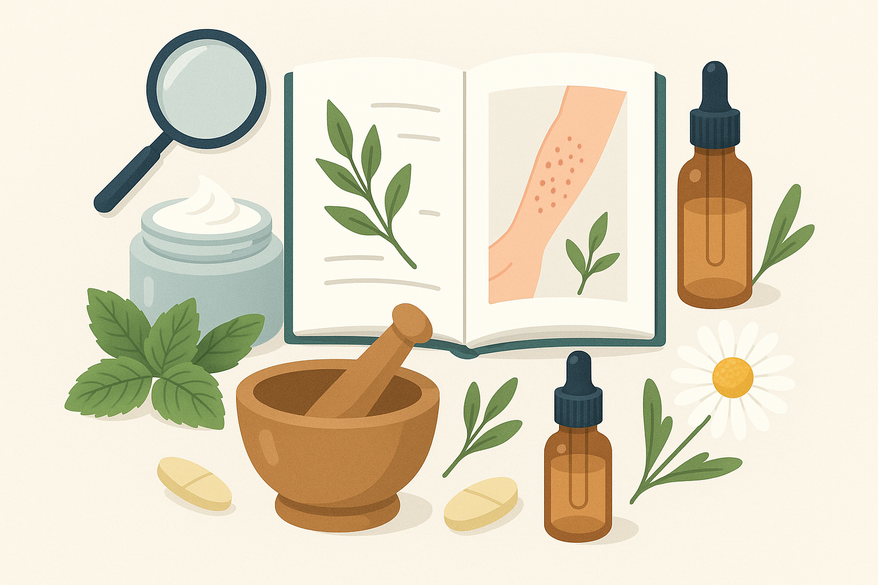Comparing Natural Remedies for Rash: An In-Depth Guide
Explore effective natural remedies for rash with this in-depth guide. Learn about efficacy, safety, and practical usage to choose the best option.

Estimated reading time: 7 minutes
Key Takeaways
- Natural remedies like aloe vera and oatmeal baths can soothe rashes with minimal side effects.
- Evaluating efficacy, safety, accessibility, and cost is crucial when selecting a remedy.
- Always perform a patch test before widespread application.
- Seek professional care if a rash shows signs of infection or spreads rapidly.
- Comparing remedies empowers you to personalize treatment based on your skin type and needs.
Table of Contents
- Introduction
- Understanding Rashes
- Overview of Natural Remedies
- Evaluation Criteria for Comparing Remedies
- Detailed Comparison of Natural Remedies
- Practical Application and Usage
- Safety Considerations and When to Seek Medical Advice
- Conclusion
- Additional Resources
- FAQ
Introduction
When it comes to treating rashes, going natural can offer gentle relief without the heavy side effects of steroids or antihistamines. From ancient herbal traditions to modern DIY skincare, plant-based ingredients are celebrated for soothing irritated skin. In this guide, we’ll compare top natural remedies side by side—examining their benefits, ease of use, and safety profiles.
Understanding Rashes
A rash is an area of irritated, swollen, or red skin that may feel itchy or painful. Causes range from mild heat rash to chronic eczema flare-ups, and pinpointing the trigger is key to effective treatment.
Common triggers include:
- Allergies (food, pollen)
- Contact irritants (soaps, fabrics)
- Infections (bacterial, viral, fungal)
- Heat and sweat
- Chronic conditions (eczema, psoriasis)
- Medication reactions
By tackling the underlying cause, you can prevent recurrence and improve long-term skin health.
Overview of Natural Remedies
Below is a quick summary of the most popular natural treatments for rashes:
- Aloe vera – Soothing, anti-inflammatory gel; hydrates and calms mild irritations.
- Oatmeal baths – Colloidal oatmeal reduces itching and inflammation. Read more: Oatmeal Bath for Rash
- Coconut oil – Multi-purpose moisturizer with mild anti-inflammatory action.
- Chamomile – Anti-inflammatory compress; rich in azulene and bisabolol.
- Tea tree oil – Antimicrobial and anti-inflammatory; use diluted for fungal or allergic rashes.
- Calendula – Healing topical from marigold petals.
- Apple cider vinegar – Diluted antiseptic; can sting if undiluted.
- Epsom salts – Magnesium-rich soak to reduce swelling.
- Cold compress – Immediate cooling for itch relief.
Evaluation Criteria for Comparing Remedies
We assess each remedy using the following factors:
- Efficacy – Symptom relief and healing support.
- Safety – Risk of side effects or allergies.
- Accessibility – Ease of sourcing ingredients.
- Cost – Average price per treatment.
- Ease of use – Preparation and application simplicity.
- User feedback – Anecdotal reports and traditional use.
Detailed Comparison of Natural Remedies
Below is a side-by-side look at how each treatment stacks up:
- Aloe vera: Highly soothing, widely available, minimal cost.
- Oatmeal baths: Excellent for widespread itching, requires bath time.
- Coconut oil: Great moisturizer, low risk, may clog pores.
- Chamomile: Gentle anti-inflammatory, limited availability fresh.
- Tea tree oil: Powerful antimicrobial, must dilute to avoid irritation.
- Calendula: Effective for healing, moderately priced.
- Apple cider vinegar: Antiseptic, stings undiluted.
- Epsom salts: Eases swelling, simple soak.
- Cold compress: Immediate relief, no cost.
Practical Application and Usage
Patch Test Reminder: Before full use, apply a small amount behind your ear or on the forearm. Wait 24 hours to check for redness or itching.
- Aloe vera: Extract fresh gel; apply 2–3 times daily.
- Oatmeal bath: Add 1 cup colloidal oatmeal to a lukewarm bath; soak 15–20 minutes.
- Coconut oil: Clean area; apply a thin layer twice daily.
- Chamomile compress: Steep flowers in hot water; cool and apply as a compress.
- Tea tree oil: Dilute 2–3 drops in 1 tsp of carrier oil; apply once daily.
For an AI-driven analysis, consider using Rash Detector to upload images and receive an instant report.

Safety Considerations and When to Seek Medical Advice
Natural doesn’t always mean risk-free. Always perform a patch test and monitor for adverse reactions.
Red flags include:
- Rapidly spreading or severe rash
- Signs of infection (fever, pus, severe pain)
- Rash in sensitive areas (eyes, mouth, genitals)
- Underlying health issues or conflicting medications
Medical Disclaimer: This guide is for educational purposes and not a substitute for professional advice. Consult a healthcare provider before starting any new skin treatment.
Conclusion
No single remedy suits everyone. By comparing factors like efficacy, safety, cost, and ease of use, you can tailor your approach for short-term relief or long-term care. For an in-depth product comparison, see OTC vs Prescription Rash Treatment. Share your experiences in the comments to help our community learn and grow.
Additional Resources
- Healthline’s Home Remedies Overview
- K Health Guide on Rash Home Remedies
- Tuasaude’s Herbal Remedy Summaries
- Oatmeal Bath for Rash
- OTC vs Prescription Rash Treatment
FAQ
- How long do natural remedies take to work?
Results vary, but most soothing effects appear within minutes to hours. Full healing may take days. - Are natural rash remedies safe for children?
Many are gentle enough, but always perform a patch test and consult a pediatrician if unsure. - When should I see a doctor for a rash?
Seek medical attention if a rash spreads rapidly, shows infection signs, or does not improve after a week of home care.





